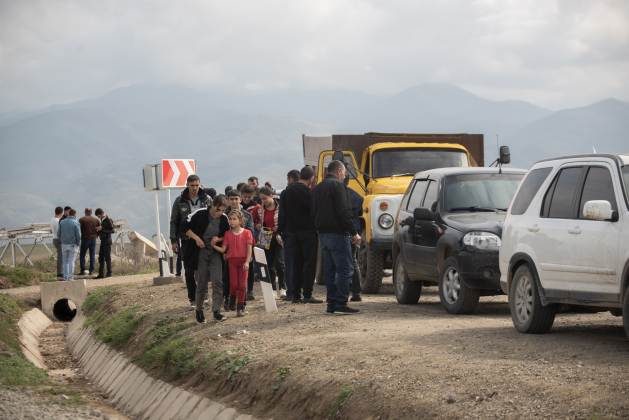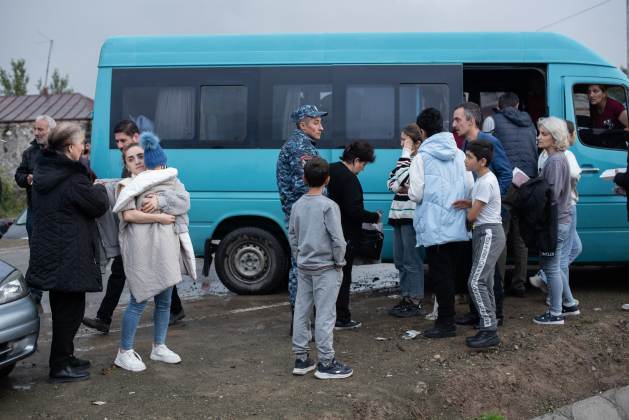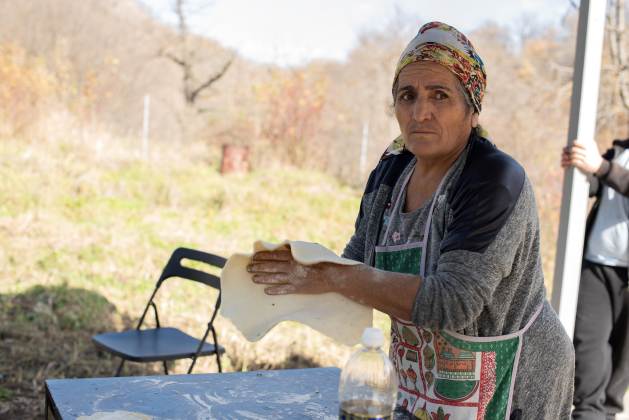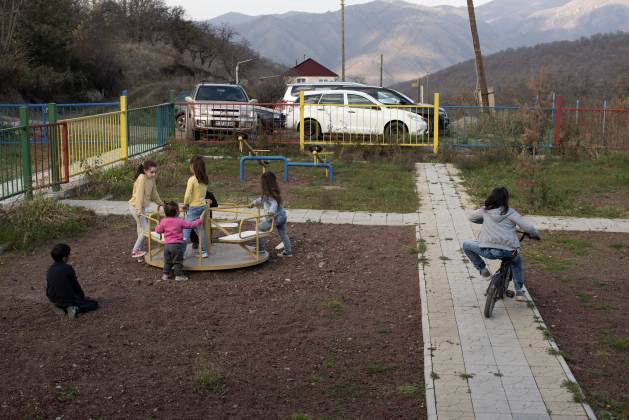Nagorno Karabakh: Displaced, But Far From Safe

TEGH, Armenia, Nov 08 (IPS) - From the balcony of the house she's lived in for the past weeks, 32-year-old Margarita Ghushunts says she often looks in the direction of her home, in Nagorno Karabakh.
“Every time I look that way, I remember the hellish journey we took to escape from home. It feels like losing it over and over again,” she tells IPS.
Also called “Artsakh” by its Armenian former residents, Nagorno-Karabakh was a self-proclaimed republic within Soviet Azerbaijan which had sought international recognition and independence since the dissolution of the Soviet Union in 1991.
The First Nagorno-Karabakh War (1988-1994) ended with an Armenian victory. Azerbaijan would unleash its armed forces in 2020 and take back many of the areas lost years before.
But grievances were still not settled.
On September 19, Azerbaijan launched a massive attack against Nagorno Karabakh. All the population —more than 100,000 ethnic Armenians— fled the region for Armenia within a few days.
Panicked by the Azerbaijani attack, the civilian population rushed to evacuate. The sole road connecting Nagorno Karabakh to Armenia —closed by a 9-month blockade imposed by Azerbaijan— had just been reopened, but it could be closed again at any moment.
After a 28-hour, exhausting ride to the Armenian border from Nagorno Karabakh´s capital city Stepanakert, Margarita, her husband Harutyun and their three minor children arrived at her father’s house in Tegh village, in southern Armenia.
The village is located right on the Azerbaijani border. Margarita can even see the Azerbaijani military positions and their flags waving from the neighbouring mountain peaks.
“We can also hear the periodic gunshots so my children cannot sleep peacefully. Even when they hear the sound of thunder, they come to me and ask: “Mama, are they shooting at us again?”

Killed and tortured
On September 28, the last leader of Nagorno Karabakh, Samvel Shajramanian, issued a decree dissolving the self-proclaimed Nagorno Karabakh Republic as of January 1, 2024.
Today, the population of the evacuated enclave is spread throughout the regions of Armenia. Some of them are in the accommodations provided by the government, while others rent houses or live in free accommodations offered by caring individuals.
In several public speeches and international meetings, Azerbaijani President Ilham Aliyev has repeatedly emphasized that the rights of Armenians living in Nagorno Karabakh would be safeguarded “with Azerbaijan's national legislation and international commitments”.
But there's little trust among the Armenians. Less than 40 remain in the besieged enclave. They are now provided with humanitarian aid by the International Committee of the Red Cross (ICRC).
On October 19, the Armenian Human Rights Defender, Anahit Manasyan, reported that the bodies of the victims in Nagorno-Karabakh during the Azeri attack from September 19-21 showed signs of torture and mutilation.
It matches data issued by Armenia’s Investigative Committee on the 31st of October which points to 14 people being tortured by the Azerbaijani military and 64 people dying on the road from Nagorno Karabakh to Armenia.
In an interview with IPS in Yerevan, southern Armenia, International law and human rights expert Siranush Sahakyan notes that previously recorded cases of brutal murders among the civilian population of Nagorno-Karabakh demonstrate the futility of Aliyev´s words.
“After the 2020 war, up to 70 civilians decided to remain in their settlements of Hadrut, Shushi and other regions which came under Azerbaijani control. All these civilians were either captured, taken to Baku, tortured and killed or murdered in their own houses. Their bodies were desecrated,” recalls Siranush Sahakyan.
UN also called on Azerbaijan that “Rights and security of Karabakh Armenians must be guaranteed”. Other than just making calls, says Siranush Sahakyan, the UN should also create the conditions for it.
“The first condition is to eliminate hatred against Armenians. Also, an international fully mandated mechanism needs to be deployed in Azerbaijan to protect Armenians in case they face security issues. Without a substantial change in the situation, no one will return,” stresses the lawyer.

Fear of new attacks
Margarita Ghushunts’s little daughter, Rozi, was born under the blockade of Nagorno Karabakh during which they were deprived of gas, electricity, food, medicine, and fuel, and the healthcare system was almost non-functional.
But it was not the harsh living conditions that forced Margarita to leave Stepanakert
“We could bear all the cruelty of the blockade to protect our right of self-determination, but as Artsakh’s government was forced to surrender arms to save the civil population, we could not stay there anymore,” explains the displaced woman.
Life in Artsakh without its defence army, she claims, “simply equates to death for the population.”
Today, Ghushunts her neighbours often ask if they will stay in the village. Her answer, however, is unsettling for everyone. The displaced woman fears Azerbaijani troops “may launch an attack on Armenia at any moment.”
It can happen. According to the Armenian MFA, after the 2020 war Azerbaijan has occupied 150 square kilometres of the internationally recognized territories of the Republic of Armenia.

On November 1st, The Lemkin Institute for Genocide Prevention issued a “Red Flag Alert” for the Republic of Azerbaijan in the Republic of Armenia, due to the alarming potential for an invasion of Armenia by Azerbaijan in the coming days and weeks.
Siranush Sahakyan, the International law expert interviewed by IPS, claims that the ratification of the Rome Statute on the International Criminal Court (ICC) by Armenia’s parliament on the 3rd of October could open the door to an international investigation of Azerbaijan’s crimes against Armenia.
“Non-ratification of the Rome Statute by Azerbaijan creates obstacles to investigate their crimes in Artsakh, but it will fall under jurisdiction for the crimes committed on the internationally recognised territory of Armenia starting from May 2021. This could be one of the ways to protect Armenia from future international crimes,” Sahakyan states.
The Avanesyans also left Nagorno Karabakh to settle in Vazashen, another border village in Armenia´s south. But they soon decided to move again.
“Our neighbour pointed out the Azerbaijani positions right in front of the village. He mentioned that they could not graze the cattle because the Azerbaijanis were stealing it. The children got scared, so we had to seek another shelter,” Lusine Avanesyan, a 35-year-old mother of five children told IPS from Kalavan village.
That´s where they moved again after the local guesthouse offered its rooms for the family allowing them to stay as long as they wished.
Romela Avanesyan, Lusine Avanesyan's mother-in-law, began exploring the resources available in Kalavan to start a farm as soon as they arrived.
The displaced 61-year-old remembers the pomegranate garden she planted many years ago but was forced to leave behind. While they were rushing to evacuate Karabakh, she held onto what was most precious to her: the seeds of plants and vegetables from her garden.
“I was urging my grandchildren to pick only the cracked pomegranates and leave the beautiful ones to ripen,” Avansesyan tells IPS. Today, she adds, “those pomegranates are lost, and so is our entire homeland.”
© Inter Press Service (2023) — All Rights Reserved. Original source: Inter Press Service
 Global Issues
Global Issues